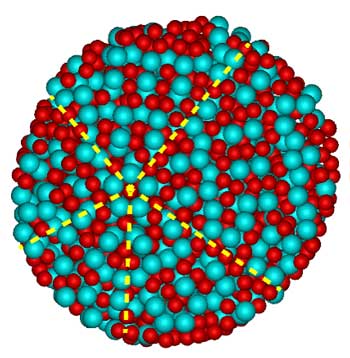| Sep 14, 2020 | |
Nanoballs packed under spherical confinement adopt a special structure(Nanowerk News) The way that balls can be stacked in 3 dimensions seems like a simple topic. For example, you could think of how to put as many ping-pong balls as possible in a jar. However, the smaller the balls, the more difficult it is to find an answer. Stacking of balls is therefore still a very intriguing problem, not only in physics, chemistry and materials science, but also in mathematics. |
|
Exotic structure |
|
| If one tries to stack 12 balls around a central ball, the most efficient way leads to a so-called icosahedron. This exotic structure inspired scientists to investigate what the stack looks like when you want to use about 10,000 nanoparticles. A nanoparticle is about a hundred thousand times smaller than a ping-pong ball. | |
| This mystery was recently solved thanks to a collaboration between researchers from the Soft Condensed Matter group at Utrecht University, scientists from the Department of Chemistry at the University of Pennsylvania and the EMAT Electron microscopy group at the University of Antwerp. | |
| The results of the study were published in the leading journal Nature Physics ("Binary icosahedral clusters of hard spheres in spherical confinement"). | |
 |
|
| Electron microscopy reconstruction of the binary nanoparticle cluster that forms a three-dimensional icosahedral structure. Yellow dotted lines illustrate the five-fold symmetry. (Image courtesy of the researchers) | |
| “We examined mixtures of nanoballs with two different diameters,” explains Prof. Sara Bals (UAntwerpen). “The spheres were enclosed in spherical drops of oil and water. It is very challenging to determine the stacking of such small particles in three dimensions and that is why our powerful electron microscopes were used. The technique that was used is called electron tomography and it allows to view nanomaterials in three dimensions. These results showed that the stacking differs from the structure that you would expect for classic crystals. The icosahedral structure that was observed is in fact strongly related to quasicrystals that show a five-fold symmetry, which is classically 'forbidden'.” | |
| The researchers showed both experimentally and by performing simulations that the mixture of binary nanoparticles that would usually crystallize into a bulk Laves crystalline phase, can be spontaneously driven towards the formation of icosahedral clusters by confinement in slowly drying droplets. | |
| These new insights not only lead to a new fundamental understanding of crystallization, but also allow scientists to create new “photonic crystals”. These structures occur naturally in opal or in the wings of a butterfly. By growing photonic crystals with nanoparticles, the propagation of light can be influenced. This makes it possible to make special coatings such as paint that changes color depending on the direction you look along. There are also applications within telecommunications. |
| Source: University of Antwerp | |
|
Subscribe to a free copy of one of our daily Nanowerk Newsletter Email Digests with a compilation of all of the day's news. |
